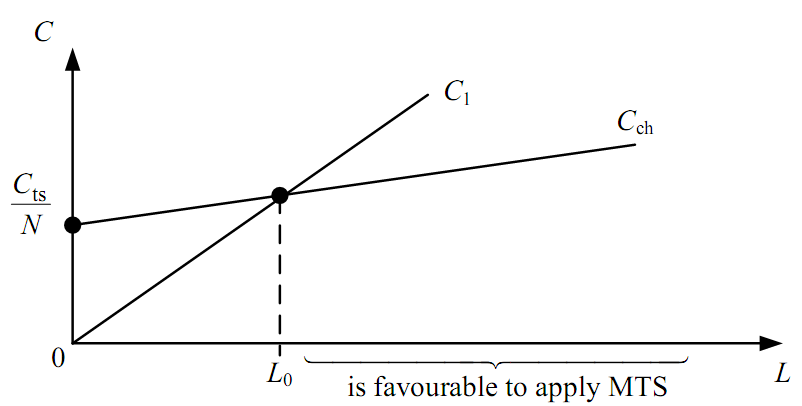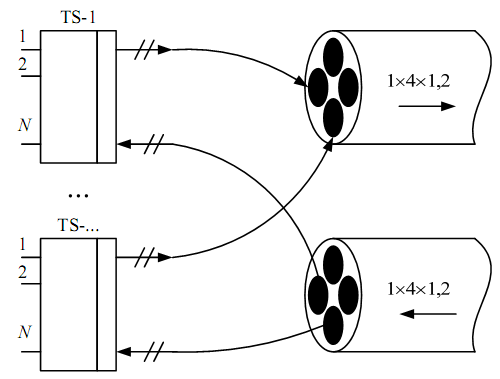
- •Table of contents
- •1 Section Telecommunication public network
- •1.1 Types of telecommunication networks
- •1.2 The basic elements of the pn (the network elements)
- •2 Section Transmission systems
- •2.1 Functions and the basic elements of the transmission systems
- •2.2 The repeater section length
- •2.3 The level diagram
- •2.4 The classification of TrS:
- •2.5 The necessity of the group signal transmission
- •3 The multiplexing methods
- •3.1 Frequency (spectral) division channeling fdc (sdc)
- •3.1.1 Filter method
- •3.1.2 Phase difference method
- •3.2 Time division channeling
- •4 Duplex organization methods
- •4.1.3 A four-wire one-band duplex
- •4. 2 Decoupling devices
- •5 Transmission channels.
- •5.1 The main parameters of vbc
- •5.2 Transit connections
- •Types of the communication networks
- •Classification of communication networks
- •6.2 A Telephone Connection
- •6.3 An atm Connection
- •6.4 An mpls Connection
- •6.5 A Wavelength Routing Optical Network Connection
2.3 The level diagram
There are internal and external LDs. LD – is the graph of signal’s level dependence during the propagation through the equipment units (internal) or through the transmission system elements (external). Let’s draw the external LD of TrS.
In order to determine the NRS number:

Let’s check the length of the lsh:
lsh = L – NNRS · lnom = 9.6 km
Let’s check the lmin < lsh < lnom condition:
lmin = 0.5 · lnom = 0,5 · 13.6 = 6.8 km.
6.8 < 9.6 < 13.6 km – in this case we have one shortened section near the TS.
(if lmin > lsh it’s necessary to recalculate lsh by using the next formula: lsh’ = (lnom + lsh)/2 . In this case we obtain 2 shortened sections near the both TS).
The shortened section has the different length from nominal section. In order to compensate it we use the artificial line unit. It’s necessary because of the same characteristics of NRS. In CA we’ll determine the lal by the next formula: lal = lnom – lsh.
prec nom = ptr – αt · lnom
prec sh = ptr – αt · lsh

prec1 prec2 prec3 prec n prec TS
NRS 1/1
NRS 1/2
NRS 1/3
NRS 1/14


Asec
Ai
Prec nom

lsh
lnom
lnom
lnom


Prec sh
L

lal = 4 km
Pn

Figure 2.5
2.4 The classification of TrS:
By the network section at which TrS is being operated: MLN, IAN, SSN, MAN, RAN.
By the used propagation media: wireline TrS and radio TrS.
By the type of signal’s transformation and the group signal transmission through the line path: analog (ATS) and digital (DTS) (the group signals are an. and d. respectively). ATS can transfer the digital information too (using the modem). DTS can transfer analog signal, but at first it will be transformed to a digital form (by means of pulse code modulation (PCM)).
By the way of channeling in receiver: SDC (spectral division ch.) in ATS, TDC (time division ch.) in DTS.
By the method of duplex communication organization.
by quantity of used frequency band (one-band and two-band);
by quantity of used wires (2-wire and 4-wire);
by quantity of used cables (1-cable and 2-cable).
The TrSs of primary network provide the bidirectional communication channels to the subscriber (transmission and receiving simultaneously).
2.5 The necessity of the group signal transmission
The economic suitability of TrS usage. Let’s compare two costs variants of communication between two subscribers without using of TrS (C1) and with TrS(C2).
![]() –
is
for one subscriber,
–
is
for one subscriber,
C1km pl – the cost of 1 km 2 wired physical line, L – the length of circuit.
![]() –
is
for several subscribers.
–
is
for several subscribers.
CTS – costs of TS.
![]() –
is
for one subscriber,
–
is
for one subscriber,
N – is the number of subscribers.
If L = L0, than C1 = C2. If L > L0, than C1 > C2. So, it’s profitably to use TrSs when the long distance communication is organized.

The all modern MTS use the grouping idea, in which the result multichannel signal is formed by the sequential transformation of the standard channel groups.
The advantages of the grouping are:
Value of TS is lower due to the filters simplification and the lower number of filters number in ATS.
The standard frequency group’s bandwidth in ATS is chosen in order to decrease the nonlinear distortions.
There are next groups in MTS FDC:
Groups |
VBC |
F1 - F2, kHz |
ΔF, kHz |
|
The name |
The notation |
|||
Pregroup |
PrG |
3 |
12-24 |
12 |
Primary |
PG |
12 |
60-108 |
48 |
Secondary |
SG |
60 |
312-552 |
240 |
Master |
MG |
300 |
812-2044 |
1232 |
It gives the possibility to unify the transformation equipment of TS and to decrease the equipment’s value and the maintenance charges.
Several MTSs work over the same transmission line in order to increase the economy.

Figure 2.6
